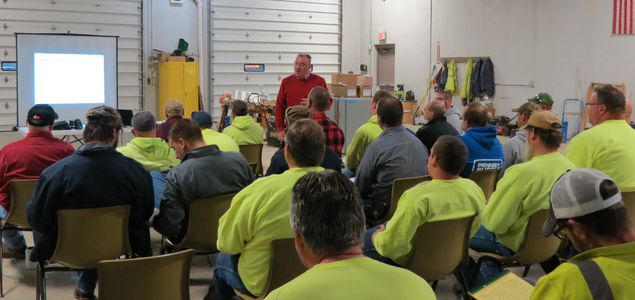
An ongoing partnership among PennDOT, the Pennsylvania State Association of Township Supervisors (PSATS) and PennDOT's Local Technical Assistance Program (LTAP) is working to enhance and develop new important winter maintenance training for local governments charged with delivering safe, passable roadways during winter events.
The original Salt and Snow Management Course was introduced as a State Transportation Innovation Council (STIC) innovation in 2015 with the goal of advancing partnerships and collaborations with local governments. The development of the original course was funded in partnership by LTAP and the Federal Highway Administration's (FHWA) STIC Incentive Program Funding.
“One of the main goals of the course when it was put together was to provide the municipalities with training on efficient and effective winter operations through the implementation of national and PennDOT best practices for salt applications,” said Sam Gregory, an LTAP technical expert and course instructor. “By presenting the course, we’ve provided the knowledge to the locals to increase their level of service while at the same time saving them material, which relates obviously to saving money.
An updated and abbreviated Salt and Snow Management Course, now called Winter Maintenance 101, was offered for the first time in December 2020 in a virtual format, said Karen Atkinson, PSATS program manager. In 2021, there were 15 classes hosted with more than 300 participants. The next class is scheduled for Sept. 26, 2022, and 13 others are scheduled through the end of the year.
Winter Maintenance 101 is focused on the operators' day-to-day work, such as planning and organization at a high level, focusing on equipment, materials and operational strategies, proper calibration of spreaders, understanding brine and pre-wetting.
“It originated just from the concept of wanting to help municipalities reduce the usage of salt on the roads,” said Atkinson. “So, it was taking the original course, which was part planning and part application, and trying to educate municipalities on some alternative uses for salt, and how to be better stewards of the environment and still meet the needs of the residents of having safe passages to their workplaces.”
Currently, a Winter Maintenance 202 course is being developed to focus on preparing management for their roles in winter maintenance operations. This course is intended to run a half-day, similar to the 101 course.
“This course will be geared towards management. Emphasizing planning and preparation strategies, such as budgeting and workforce training, material procurement, etc. So, we can touch both the field personnel with Winter Maintenance 101, and we can touch the management and the supervisors with Winter Maintenance 202,” said Gregory.
With the continuously evolving operations involved with winter maintenance, it’s only natural that the courses would need to evolve as well. Pennsylvania is also a very diverse state with many different terrains. The courses need to accommodate all road features across the state.
“There were a lot of areas that still relied on anti-skid for their unpaved and low volume roads,” said Gregory. “So, we had to add a module on anti-ski material, so we didn’t lose the focus on those people, especially the ones in rural areas.”
LTAP is continuing to offer the course yearly, receiving requests from municipalities every fall and sometimes into January, said Atkinson. The original Salt and Snow Management Course continues to evolve to provide knowledge and support to local municipalities, and advancements are being made to accommodate the vast array of participants.
For more information and to register for an upcoming course, visit LTAP's website.
ABOUT THIS BLOG
Did you know PennDOT is directly responsible for nearly 40,000 miles of highway and roughly 25,000 bridges? We oversee programs and policies affecting highways, urban and rural public transportation, airports, railroads, ports and waterways, in addition to administering the state's more than 11 million vehicle registrations and 8.8 million driver's licenses.
So, how do we do what we do? And how can we help you travel in Pennsylvania — whether it be for business or leisure — in safe and enjoyable manner? Read PennDOT Way to learn more about the department, what we do, and how and why we do it.
TAGS
50-Year Anniversary, 511PA, Aggressive Driving, Airports, Autonomous Vehicles, Bicycles, Bridges, Child Safety, Community Relations, Construction, COVID-19, Distracted Driving, District 1, District 10, District 11, District 12, District 2, District 3, District 4, District 5, District 6, District 8, District 9, DOTcom, Driver and Vehicle Services, Emergency Responders, Employment, Equity, FAQ Friday, Human Trafficking, Impaired Driving, Innovations, Live Free Ride Alive, Maintenance Monday, Motorcycles, Older Drivers, PA Motorcycle Safety Program, Pedestrians, PennDOT Connects, Ports, Public Transit, Railroads, REAL ID, Road MaP, Roadside Beautification, Rural Roads, Safety, School Buses, Seat Belts, State Transportation Innovation Council (STIC), Sustainability, Teen Drivers, Throwback Thursday, Transportation Funding, Travel in PA, Welcome Centers, Winter, Work Smart, Work Zone, Yellow Dot
LATEST POSTS
PennDOT Continues Sharing, Updating Resources for Local Governments to Pursue Bipartisan Infrastructure Law Funding Opportunities
Norwin High School Wins 2024 ‘Innovations Challenge’
Demo Complete: I-95 CAP Project in Center City Philadelphia
PennDOT Archeologist Connects Past, Present, and Future
Lehigh Valley DUI, Highway Safety Task Force Hosts Law Enforcement Seminar
ARCHIVES
2024
2023
2022
2021
2020
2019
2018
2017

